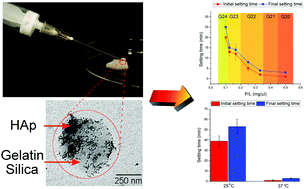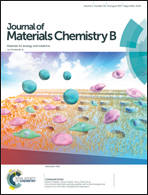Antimicrobial hydroxyapatite–gelatin–silica composite pastes with tunable setting properties†
Abstract
Bone grafting is one of the commonest surgical procedures, yet all bone substitutes developed so far suffer from specific weaknesses and the search for a bone graft material with ideal physical and biological properties is still ongoing. Calcium phosphate pastes are the most frequently used synthetic bone grafts, yet they (a) often take an impractically long time to set, (b) release the drug content too fast, and (c) do not form pores large enough to accommodate host cells and foster osseointegration. To make up for these deficiencies, we introduced gelatin and silica to pastes composed of 5–15 nm sized hydroxyapatite nanoparticles and yielded a bioresorbable composite that is compact, yet flowing upon injection; that prevents setting at room temperature, but sets promptly, in minutes, at 37 °C; that displays an increase in surface porosity following immersion in physiological fluids; that allows for sustained release of antibiotics; and that sets in a tunable manner and in clinically relevant time windows: 1–3 minutes at its fastest. Timelapse, in situ X-ray diffraction analysis demonstrated that the setting process is accompanied by an increase in crystallinity of the initially amorphous hydroxyapatite, involving no polymorphic phase transitions in its course. Setting time can be tuned by controlling the weight content of gelatin or powder-to-liquid ratio. The release of vancomycin was slow, ∼8% after 2 weeks, and unaffected by the gelatin content. While vancomycin-loaded pastes were effective in reducing the concentration of all bacterial species analyzed, the bacteriostatic effects of the antibiotic-free pastes were pronounced against S. liquefaciens and E. coli. S. liquefaciens bacilli underwent beading and filamentation during the treatment, suggesting that the antimicrobial effects are attributable to cell wall disruption by hydroxyapatite nanoparticles. Vancomycin-loaded pastes augmented the activity of the antibiotic against P. aeruginosa and S. liquefaciens, while exhibiting no negative effects against human mesenchymal stem cells. They were also uptaken three times more abundantly than pure hydroxyapatite, indicating the theoretical favorability of their use for intracellular delivery of therapeutics. This selectivity, toxic for bacteria and harmless for primary stem cells, is promising for application as bone grafts for osteomyelitis.



 Please wait while we load your content...
Please wait while we load your content...